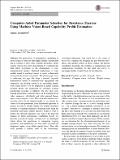Files in this item
Computer-aided parameter selection for resistance exercise using machine vision-based capability profile estimation
Item metadata
| dc.contributor.author | Arandelovic, Ognjen | |
| dc.date.accessioned | 2017-08-01T14:30:11Z | |
| dc.date.available | 2017-08-01T14:30:11Z | |
| dc.date.issued | 2017-12 | |
| dc.identifier | 250562562 | |
| dc.identifier | db7887d1-a96a-4f7e-a356-e47e8f4681f1 | |
| dc.identifier.citation | Arandelovic , O 2017 , ' Computer-aided parameter selection for resistance exercise using machine vision-based capability profile estimation ' , Augmented Human Research , vol. 2 , 4 . https://doi.org/10.1007/s41133-017-0007-1 | en |
| dc.identifier.issn | 2365-4317 | |
| dc.identifier.other | ORCID: /0000-0002-9314-194X/work/164895885 | |
| dc.identifier.uri | https://hdl.handle.net/10023/11343 | |
| dc.description.abstract | The penetration of mathematical modelling in sports science to date has been highly limited. In particular and in contrast to most other scientific disciplines, sports science research has been characterized by comparatively little effort investment in the development of phenomenological models. Practical applications of such models aimed at assisting trainees or sports professionals more generally remain nonexistent. The present paper aims at addressing this gap. We adopt a recently proposed mathematical model of neuromuscular engagement and adaptation, and develop around it an algorithmic framework which allows it to be employed in actual training program design and monitoring by resistance training practitioners (coaches or athletes). We first show how training performance characteristics can be extracted from video sequences, effortlessly and with minimal human input, using computer vision. The extracted characteristics are then used to fit the adopted model i.e. to estimate the values of its free parameters, from differential equations of motion in what is usually termed the inverse dynamics problem. A computer simulation of training bouts using the estimated (and hence athlete specific) model is used to predict the effected adaptation and with it the expected changes in future performance capabilities. Lastly we describe a proof-of-concept software tool we developed which allows the practitioner to manipulate training parameters and immediately see their effect on predicted adaptation (again, on an athlete specific basis). Thus, this work presents a holistic view of the monitoring–assessment–adjustment loop which lies at the centre of successful coaching. By bridging the gap between theoretical and applied aspects of sports science, the present contribution highlights the potential of mathematical and computational modelling in this field and serves to encourage further research focus in this direction. | |
| dc.format.extent | 19 | |
| dc.format.extent | 4142062 | |
| dc.language.iso | eng | |
| dc.relation.ispartof | Augmented Human Research | en |
| dc.subject | Capability profile | en |
| dc.subject | Strength | en |
| dc.subject | Force | en |
| dc.subject | Estimation | en |
| dc.subject | Computer vision | en |
| dc.subject | Software | en |
| dc.subject | Weight training | en |
| dc.subject | QA75 Electronic computers. Computer science | en |
| dc.subject | QA76 Computer software | en |
| dc.subject | QP Physiology | en |
| dc.subject | NDAS | en |
| dc.subject.lcc | QA75 | en |
| dc.subject.lcc | QA76 | en |
| dc.subject.lcc | QP | en |
| dc.title | Computer-aided parameter selection for resistance exercise using machine vision-based capability profile estimation | en |
| dc.type | Journal article | en |
| dc.contributor.institution | University of St Andrews. School of Computer Science | en |
| dc.identifier.doi | 10.1007/s41133-017-0007-1 | |
| dc.description.status | Peer reviewed | en |
This item appears in the following Collection(s)
Items in the St Andrews Research Repository are protected by copyright, with all rights reserved, unless otherwise indicated.

